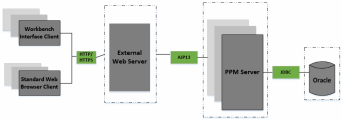Server Cluster/External Web Server Configuration
The server cluster/external Web server configuration distributes client connections evenly among any number of nodes, based on Web traffic and server load. This configuration is typically used for organizations that need to load-balance Web traffic across multiple nodes (as an alternative to hardware-based load balancing). It can also be useful to an organization that already uses a standard Web server within its network infrastructure.
You can usually improve user load, transaction capacity, and system performance with this configuration. The extent of improvement depends on the number of nodes in the cluster and their available resources. This configuration supports load balancing and server failover features.
Server cluster/external Web server configuration
The Web server (internal or external) listens for HTTP or HTTPS requests from standard web browser clients and workbench interface clients. Nodes run in the background and are transparent to users. Users access only the URL to the Web server.
The Web server forwards HTTP or HTTPS requests to one of the nodes. The PPM Web server and the nodes communicate using Apache JServ Protocol version 1.3 (AJP13).
The PPM Server uses JDBC to communicate with the Oracle database.
The nodes also accept TCP/UDP connections from other nodes for cache synchronization and cluster monitor.










